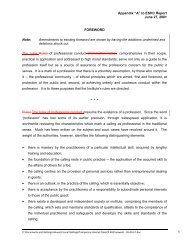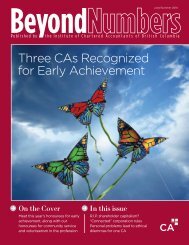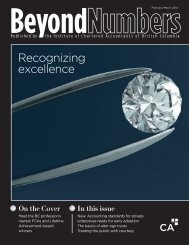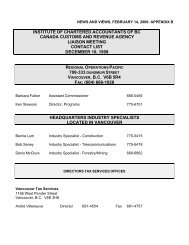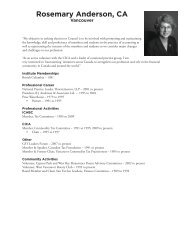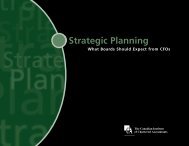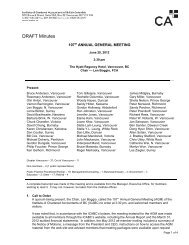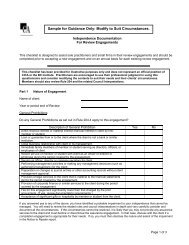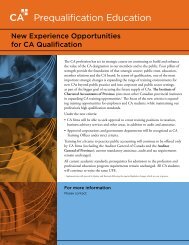Ali Pejman, CA - Institute of Chartered Accountants of BC
Ali Pejman, CA - Institute of Chartered Accountants of BC
Ali Pejman, CA - Institute of Chartered Accountants of BC
Create successful ePaper yourself
Turn your PDF publications into a flip-book with our unique Google optimized e-Paper software.
Employment Tax Traps & Opportunities<br />
Tips<br />
for dispositions that occur after February<br />
27 th , 2000. The Budget also proposes<br />
to increase the deduction under paragraphs<br />
110(1)(d) and (d.1) from ¼ to 1/3 <strong>of</strong><br />
the share option benefit, to keep the<br />
treatment <strong>of</strong> share options consistent<br />
with that <strong>of</strong> capital gains.<br />
The result <strong>of</strong> these changes is an<br />
income inclusion <strong>of</strong> 2/3 <strong>of</strong> the value <strong>of</strong><br />
the benefit on eligible options in the<br />
year the shares are actually disposed.<br />
With proper planning, and due regard to<br />
fluctuations in market prices for their<br />
shares, employees may be able to defer<br />
the income inclusion <strong>of</strong> the option<br />
benefits until later years, or years where<br />
their other sources <strong>of</strong> income are<br />
limited. This may allow employees to<br />
defer and reduce their taxes by using<br />
lower rates <strong>of</strong> tax and tax credits, and<br />
optimize their earned income for the<br />
purposes <strong>of</strong> computing their RRSP<br />
contribution room.<br />
Partial Dispositions <strong>of</strong> Identical<br />
Properties:<br />
Some employees who have share<br />
options may also own shares <strong>of</strong> their<br />
employer from purchases in the<br />
market or participation in employee<br />
share purchase plans. The Act contains<br />
rules that affect the computation <strong>of</strong><br />
the ACB <strong>of</strong> identical properties, such as<br />
shares <strong>of</strong> a corporation. The ACB <strong>of</strong><br />
identical properties is averaged over<br />
all the identical properties, and no<br />
specific identification <strong>of</strong> lots, and<br />
corresponding allocation <strong>of</strong> ACB, is<br />
allowed where the Grantor <strong>of</strong> the<br />
option was not a CCPC at the time the<br />
option was granted.<br />
In the past, the disposition <strong>of</strong> a<br />
portion <strong>of</strong> the shares held would be<br />
considered as a prorata disposition <strong>of</strong><br />
all identical properties held. Where an<br />
employee acquires additional securities<br />
<strong>of</strong> the Grantor under a share<br />
option plan, the paragraph 53(1)(j)<br />
increase in the ACB in respect <strong>of</strong> the<br />
share option benefit is, upon disposition<br />
<strong>of</strong> any <strong>of</strong> the identical properties,<br />
effectively averaged over the cost <strong>of</strong><br />
all the identical properties. Because an<br />
employee may hold a number <strong>of</strong><br />
identical properties (other shares <strong>of</strong><br />
the Grantor) with a lower adjusted<br />
cost base, a significant capital gain<br />
could result from the application <strong>of</strong><br />
this position. The CCRA has recently<br />
stated, in Income Tax Technical News<br />
No. 19, that<br />
where it would seem obvious to conclude<br />
that the particular securities acquired under a<br />
Section 7 option are in fact the securities that<br />
are being disposed <strong>of</strong> by the employee, we have<br />
concluded that the current legislation permits<br />
an employee to instead identify the securities<br />
acquired under the option as those being<br />
disposed <strong>of</strong>. In order to support specific<br />
identification, the employee would have to show<br />
the correlation between the particular acquisition<br />
and disposition <strong>of</strong> securities.<br />
This change to the administrative<br />
policy means that employees who hold<br />
shares acquired outside the option plan<br />
can, with a modicum <strong>of</strong> planning, sell<br />
shares at the exercise and avoid any<br />
dilution <strong>of</strong> the increase in the cost base<br />
in their shares as a consequence <strong>of</strong> the<br />
Section 7 benefit.<br />
It will be interesting to see how the<br />
Department <strong>of</strong> Finance considers the<br />
identical properties question when<br />
drafting the law on the $100,00 deferral.<br />
Many employees will have options<br />
that exceed the $100,000 threshold, and<br />
will therefore require two “pools” <strong>of</strong><br />
shares exercised, one that includes a<br />
53(1)(j) bump as a result <strong>of</strong> the Section 7<br />
benefit, and one that does not.<br />
Conclusion:<br />
The recent changes illustrate the<br />
Department <strong>of</strong> Finance’s recognition <strong>of</strong><br />
the key role that share options play in<br />
attracting and retaining the skilled<br />
work force that Canada needs to move<br />
into the future successfully. The<br />
taxation <strong>of</strong> share options is one <strong>of</strong> the<br />
few areas where Canada is becoming<br />
competitive with the United States,<br />
largely as a result <strong>of</strong> the 2000 Budget<br />
measures, and share options will<br />
continue to be an important method <strong>of</strong><br />
compensation for the employees <strong>of</strong><br />
new ventures and established businesses<br />
in Canada.<br />
26 Beyond Numbers / September 2000




